32 Essential AI Statistics You Need to Know in 2025

Contents
- AI Usage Statistics
- Artificial Intelligence Growth Statistics
- AI in the UK Statistics
- Global AI Statistics
- AI for Marketing Statistics
- AI for Business Statistics
- AI in the Retail Industry Statistics
- AI in the Workplace
- Machine Learning and AI Statistics
- The Future of AI
- Enjoyed reading these statistics? Find more statistics you need to know in 2025 here:
Artificial intelligence (AI) is continuing to take businesses by surprise with its capabilities and potential. From cost savings to new growth opportunities, AI opens doors for companies and consumers on a global scale.
Dive into the top AI statistics that show why AI is one of the fastest-growing markets of 2025 and how businesses are using this cutting-edge technology to beat the competition and grow their profits.
AI Usage Statistics
How many people use AI, and how do most people and businesses use this developing technology? Let’s take a look at the statistics which reveal just how extensive AI is in 2025.
AI Can Help Businesses Scale
Businesses are increasingly reliant on AI. And, consumer preferences and needs are changing as a result. 81% of customers anticipate quicker service with the advancement of technology, while 73% are on the lookout for enhanced personalization.
Nearly Half the U.S. Population Use Voice Assistants
In 2022, about 142 million people in the United States chatted it up with voice assistants—that's nearly half the population. Fast forward to 2026, and we're expecting an uptick to 157.1 million users.

Companies Use AI to Address Skill Shortages and Environmental Challenges
A quarter of businesses use AI to fill talent gaps. About 20% use AI because of pressures like customer expectations or competition.
Services Holds 39.64% of the AI Market Share
Services hold the most significant percentage of the AI market share, followed by software at 36.98% and hardware at 23.38%. The reason services rule the AI market is simple—it's all about the ease and flexibility of using artificial intelligence (AI) as a service for your AI applications. AI projects are pretty complicated, needing a mix of skills in things like computer vision, language processing, and machine learning. People are turning to services a lot because they bring together different skills and resources to handle these tricky projects in the best way.
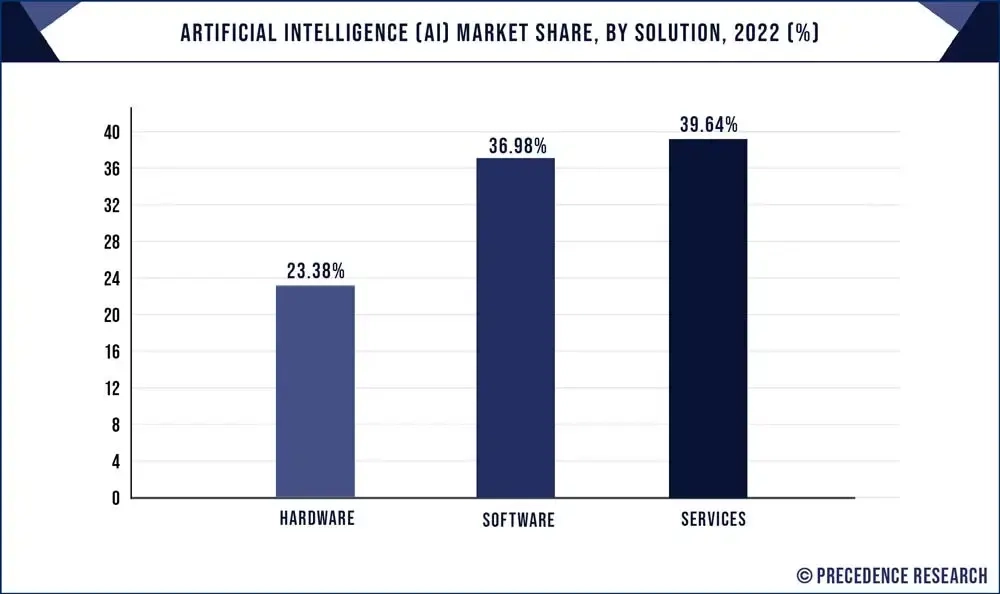
Artificial Intelligence Growth Statistics
AI steadily grows as more businesses realize its benefits and the technology becomes more accessible. Below is more on the projected growth of AI and the top contributing factors.
The Global AI Market is Expected to Reach $538.13 Billion in 2023
In 2022, the worldwide market for artificial intelligence (AI) was worth about $454.12 billion. Fast forward to 2032, and we're looking at a whopping $2,575.16 billion, growing at an annual rate of 19% from 2023 to 2032. Now, checking out North America's AI scene, it stood at $167.30 billion in 2022.
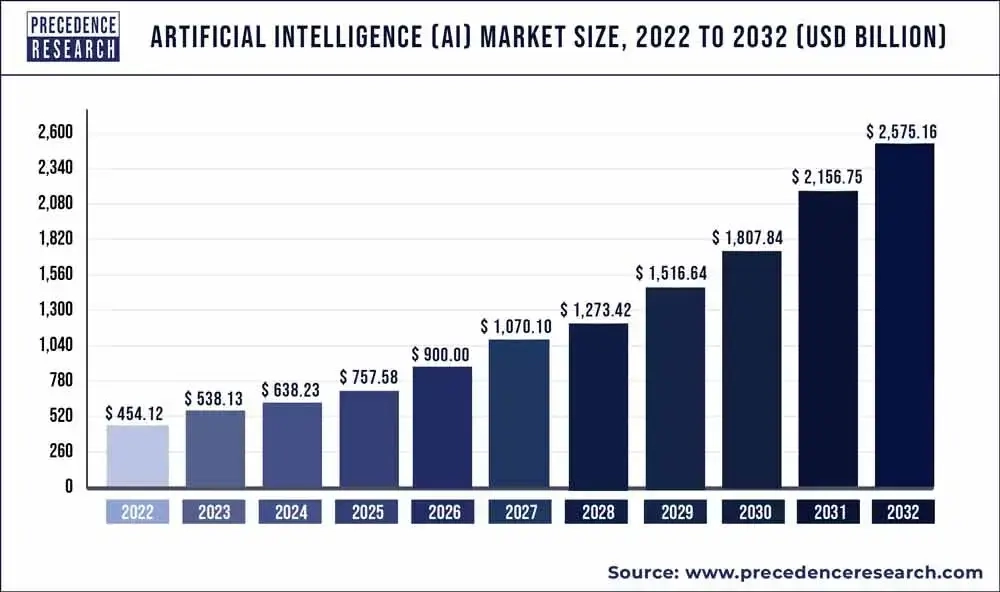
More Than 80% of Companies Have Adopted AI in Some Way
The AI wave is sweeping through businesses! More than 80% of companies have hopped on the artificial intelligence (AI) train in some way, according to various studies. For 83% of these companies, AI takes the top spot in their business strategy. Fast forward to 2025, and 80% of companies plan to embrace intelligent automation—this cool combo of AI and automation. Retail executives are catching on too, with 80% of them gearing up to adopt AI within the next three years.
Accessibility and Cost Reduction Are the Top Drivers of AI Adoption
AI adoption continues to grow as it becomes accessible. Additionally, companies use AI to reduce costs and competitive pressures.
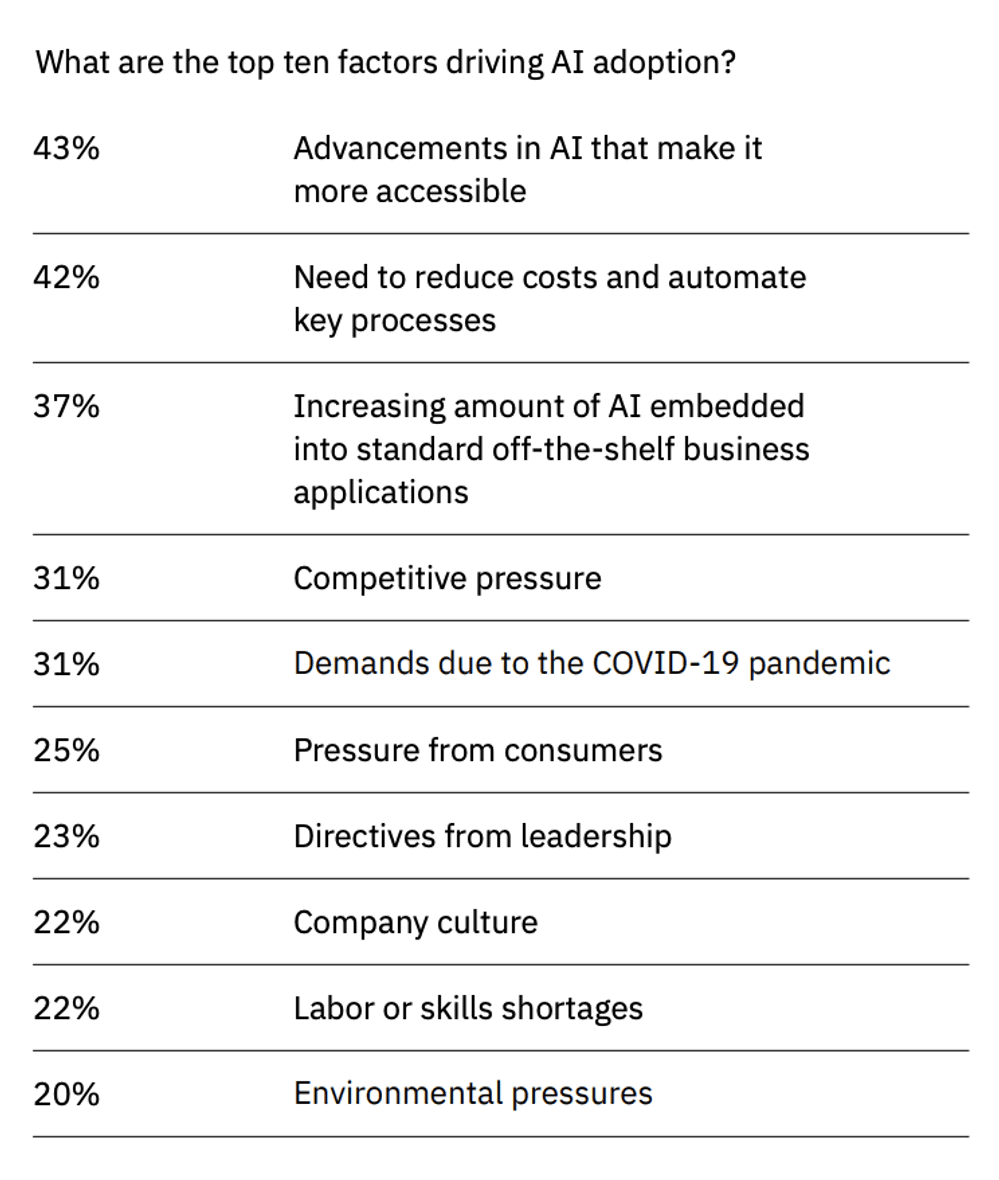
AI in the UK Statistics
UK AI adoption is not as high as in other regions, but the country is seeing a steady increase in adoption. Below are the top UK AI usage statistics for 2024.
15% of UK Businesses Use at Least One AI Technology
While AI adoption is in the minority, 432,000 businesses use at least one AI technology. Larger businesses are more likely to adopt AI as 68% of large companies use at least one AI technology compared to 15% of small businesses.
12% of UK Businesses Are Testing or Plan to Test AI
Around 2% of UK businesses are piloting AI technology in the business—an additional 10% plan to adopt AI in the future.
IT and Legal Sectors Had the Greatest AI Adoption Percentages in the UK
According to the Capital Economics report of UK businesses, 30% of IT and legal firms, 17% of manufacturing companies, and 12% of retail and hospitality companies adopted AI.
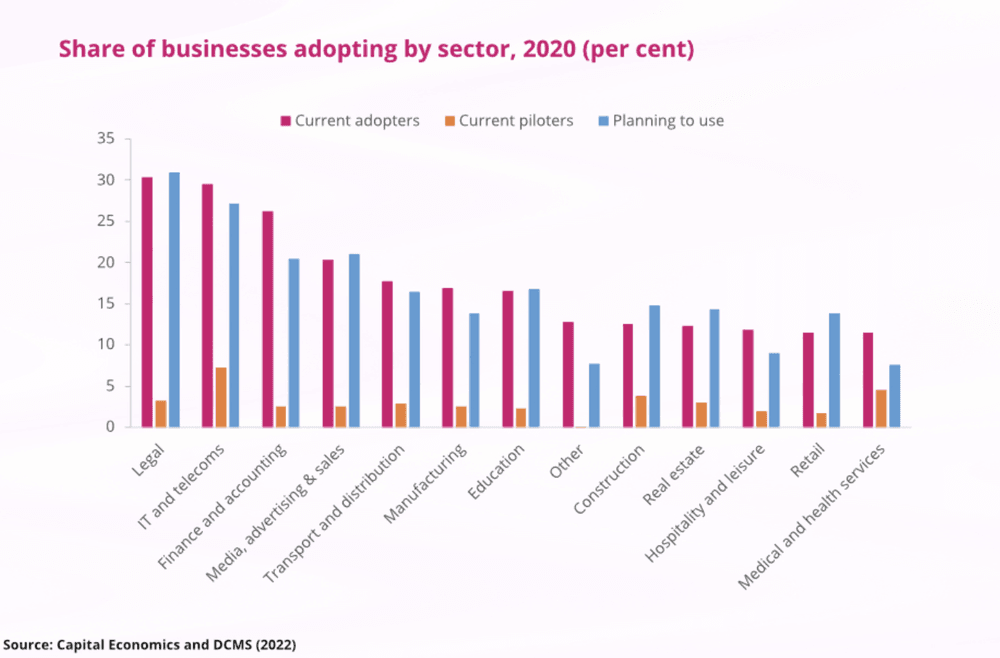
40% of Businesses Develop AI In-House
Of those businesses that use AI in the UK, about 40% purchase external AI solutions, and another 40% develop AI technology in-house. The remaining 20% outsource their AI. Medium companies are most likely to create their AI solutions in-house.
Global AI Statistics
How is the AI industry impacting global markets? Compare the adoption rates and impact of AI worldwide by reviewing the statistics below.
China Has the Highest AI Adoption Rates
About 58% of Chinese companies deployed AI, and another 30% are exploring AI adoption. India has the second-highest AI adoption percentage. The global average is 34% of companies deploying AI and 42% exploring AI adoption.
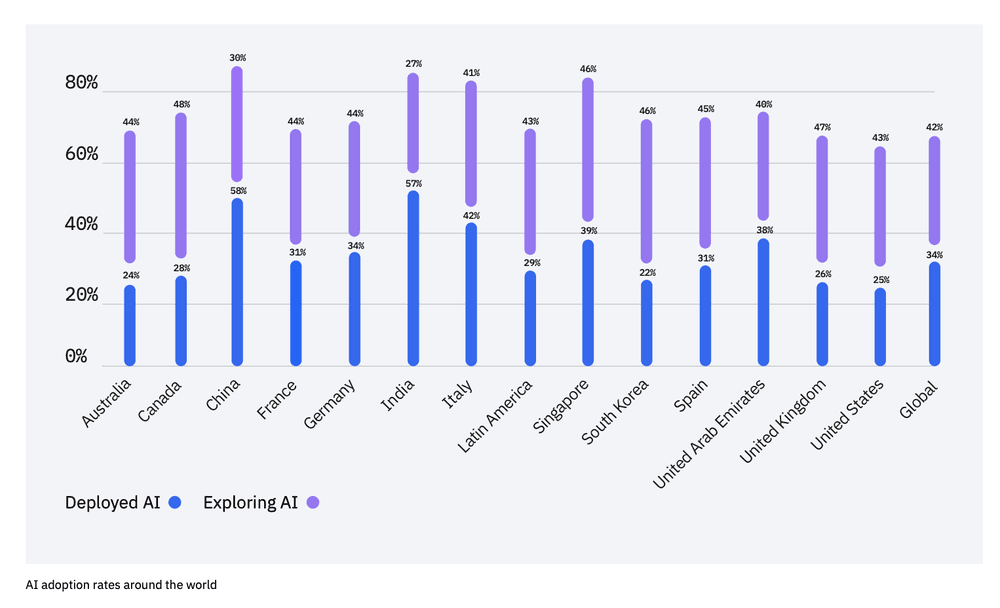
North America Had a 36.92% AI Market Share in 2024
North America held the largest AI market share in 2024. Some of the most influential businesses include:
- Intel Corporation
- Microsoft
- IBM
- Amazon Web Services
By 2025, There Will Be 100 Million AI Jobs Globally
At the rate AI is increasing, WeForum predicts 100 million AI workers globally will be in the industry. The survey also indicates that businesses globally need 97 million people to meet their growing needs.
AI for Marketing Statistics
AI promises a bright future for the marketing industry with its streamlined work processes, improved customer service, and unbeatable data processing. Below are statistics showing how AI is impacting the marketing industry.
47% of Marketers Trust AI for Ad Targeting
The top activities marketers trust AI for include:
- Ad targeting
- Real-time content personalization
- Email optimization
- Conversion calculations
- Live chat
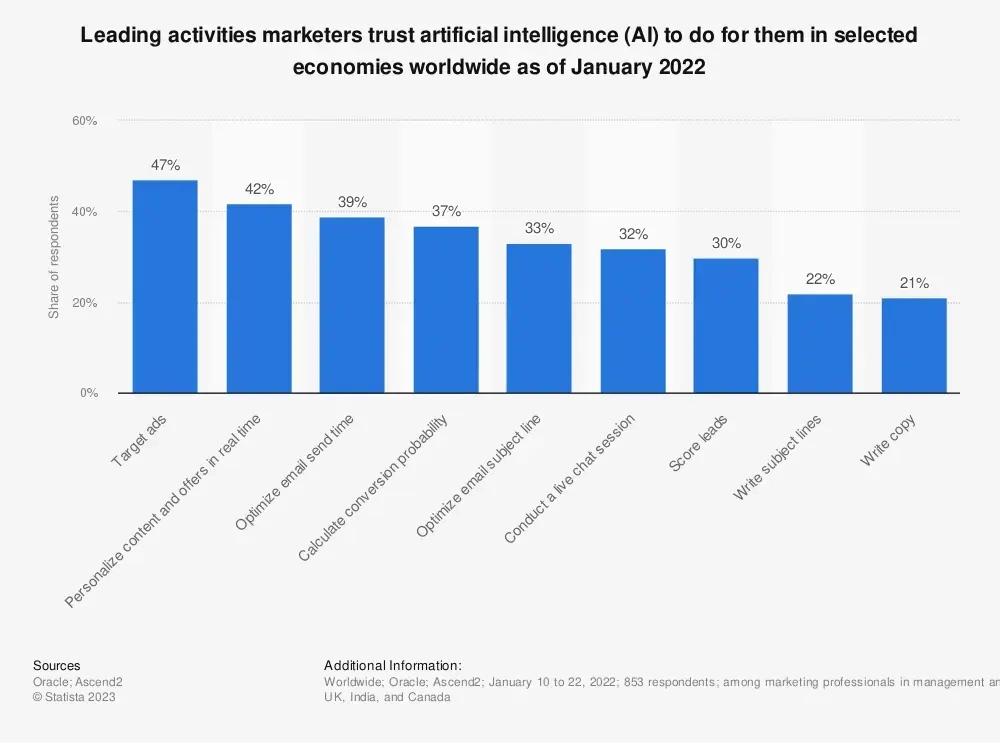
41.29% of Marketers See Increased Revenue from AI Email Marketing
Email marketing is already a powerful tool. When marketers add in AI for writing, customizing, and sending emails, they see several benefits, including:
- 41.29% saw improved revenue
- 13.44% saw improved click-through rates
- 7.64% saw improved open rates
- 1.13% saw improved delivery rates
AI for Business Statistics
How are businesses using AI? Explore how companies and AI work together to increase profits and boost growth.
35% of Businesses Use AI
Another 42% of companies are considering adding AI in the future.
92.1% of Businesses Have Seen Measurable Results from AI
Investing in data and AI comes with valuable rewards, according to 92.1% of businesses in 2022. This number has grown exponentially from 2020 when 70.3% saw measurable results from data and AI. And again, in 2017, only 48.4% of businesses saw quantifiable results.
Three-Quarters of Customers Expect Better Experiences from Companies Using New Technology
AI is impacting how businesses offer customer service. Because of all the new opportunities AI created, customers now have higher expectations. According to 67% of customers, how companies incorporate and use AI and other new technology reflects how that company operates as a whole.
While 75% of customers expect businesses to incorporate new technology, nearly the same percentage also expects companies to update how they use their current technology.
44% of Business Leaders Saw Increased Productivity through AI
Some of the highest-value benefits of AI in business include the following:
- Increased productivity
- Improved decision-making
- Improved customer experience
- Innovative products and services
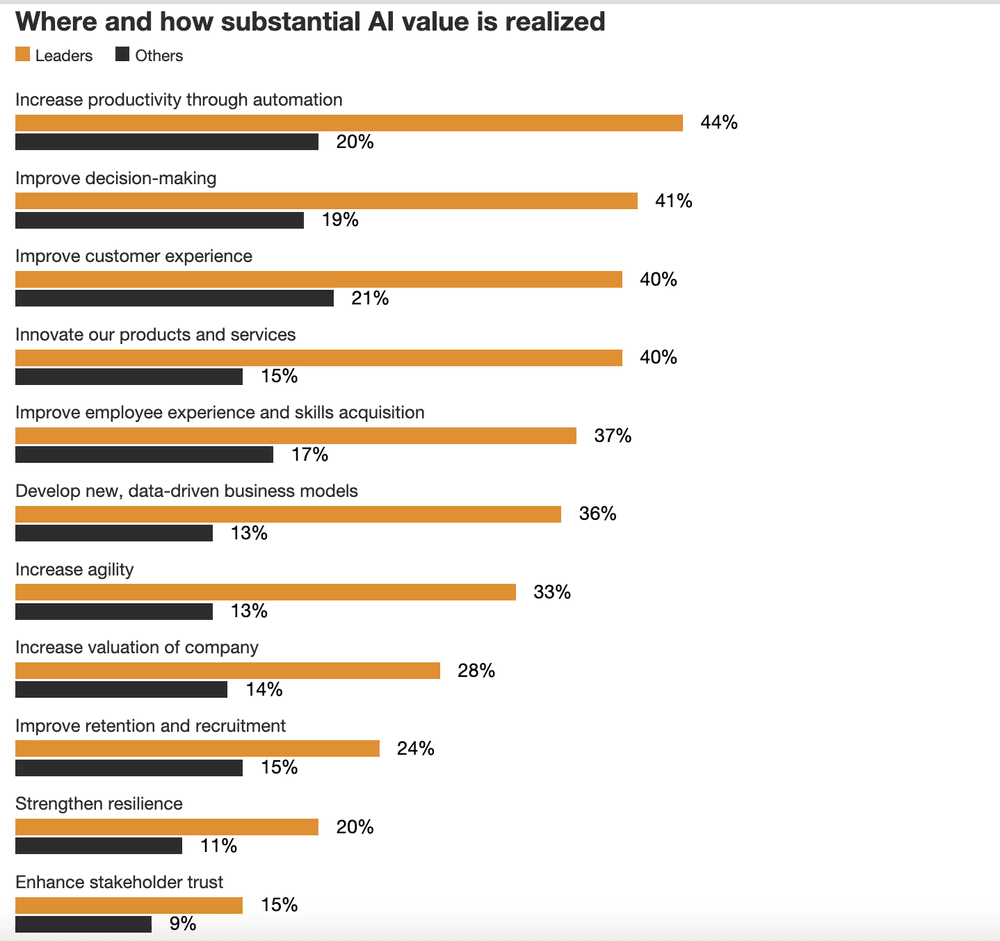
53% of Customers Believe AI Will Help Companies Offer Better Customer Service
What type of new technology do customers want businesses to use?
An increasing number of customers are open to AI because of its potential to customize and streamline experiences. Additionally, 73% of business buyers are open to AI, showing greater acceptance among business buyers than consumers.
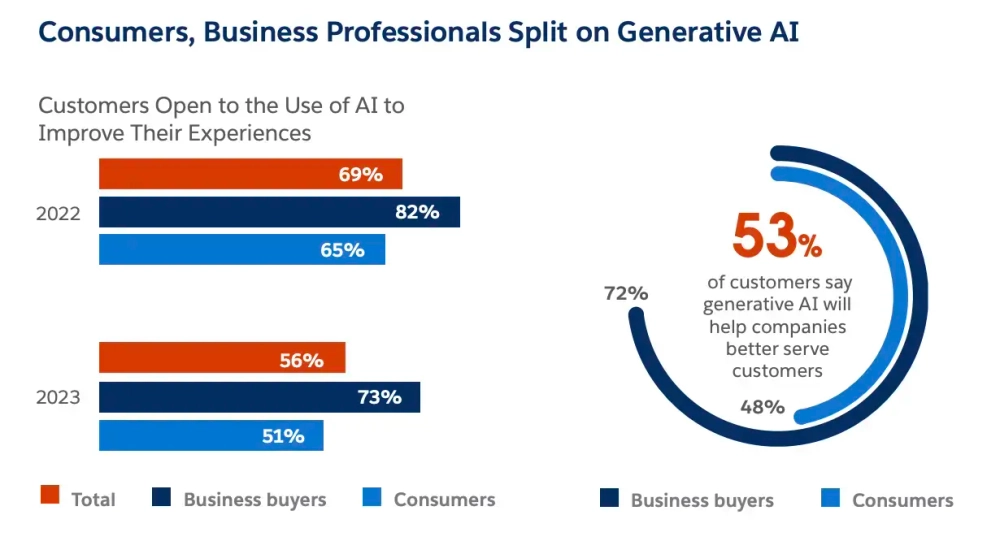
Less Than Half of Customers Trust Companies to Use AI Beneficially
Even though customers are open to AI, they don’t trust most companies using AI. For example, about 51% of consumers trust companies to use AI beneficially, compared to 73% of business buyers.
What’s influencing this distrust?
57% of consumers indicate that they would have greater trust in AI if they had more visibility into how it is used.
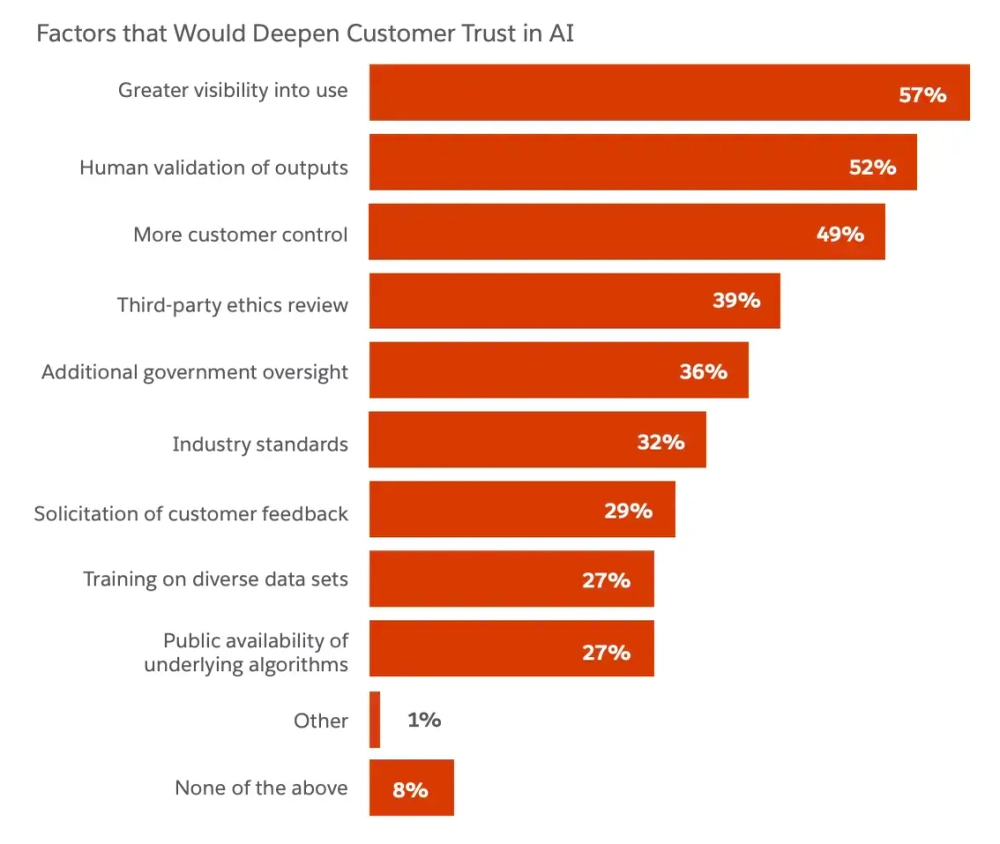
AI in the Retail Industry Statistics
AI’s adoption has come at an ideal time as more consumers are moving online to shop. As a result, AI has improved the retail industry, connecting ecommerce and in-person experiences. It also helps retail with real-time pricing and customer research.
80% of Retail Companies Expect to Adopt AI by 2025
The retail and customer products sector will significantly increase AI adoption over the next few years. A primary use of AI in retail is for customer intelligence. Already, 40% of retailers use AI, expected to grow to 80% by 2025.AI Will Contribute $15.7 Trillion to the Global Economy by 2035
Artificial Intelligence (AI) is racing through a turbocharged era of innovation and adoption, making a significant impact on retail sales. PwC predicts that AI's contribution to the global economy could soar to a whopping $15.7 trillion by the year 2035.
AI in the Workplace
Companies using AI have seen higher employee retention rates and job satisfaction. Dive into the statistics that show the many benefits of AI in the workplace.
81% of Employees Perform Better with AI
About 68% of employees want their employers to use more AI technology. Already, 56% of employees use AI daily. According to 81% of workers, one of the main reasons is improved work performance.
About 89% of employees say AI would improve at least half their workload. Other reasons include better decision-making and creativity.
Understanding Data Is the Top Workplace Task Employees Would Use AI for
About 43% of employees would use AI to understand data and trends to improve decision-making. Another 41% use it to transfer and share data.
AI Improves Employee Work-Life Balance
According to 51% of employees, AI helps workers achieve a healthier work-life balance. Because workers can complete tasks faster, they can accomplish daily tasks in less time, allowing more time to spend with friends and family.
Machine Learning and AI Statistics
Machine learning is a specific application of AI. It’s the use of data to identify patterns, replicate those patterns, find answers, and compile summaries of findings. So, while AI mimics human behaviours and intelligence, machine learning aims to learn from data and provide results without any attempt to replicate human behaviour.
Here’s a look at this specific and vital branch of AI.
Machine Learning Shows High Accuracy Rates
Several leading companies used machine learning to analyze data. Here are some of their results:
- Machine learning predicted stock market changes with a 62% accuracy rate
- Machine learning predicted the mortality of COVID-19 patients with 92% accuracy
- Google’s machine learning program can predict breast cancer with 89% accuracy
- Machine learning can prevent 86% of cyber attacks
AI and Machine Learning are Critical for 61% of Marketers
For 61% of marketers, AI and ML are key players in their data strategy. These smart technologies are the go-to tools for shaping how marketers handle their data game.
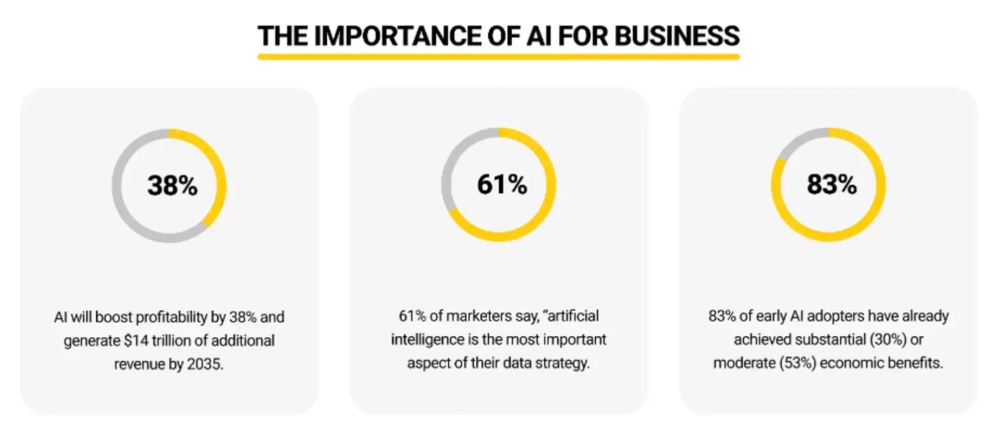
Most Companies Use 20-50 Data Sources to Inform Their AI
Reliable machine learning AI depends on quality data. More data sources give machine learning more information to work with when making decisions or creating patterns to follow.
Here are the most common number of data sources companies use to train and inform their machine learning technology:
- 21% of businesses use 20-50 data sources
- 19% of businesses use less than 20 data sources
- 18% of companies use 51-100 data sources
- 17% of businesses don’t know how many sources they use
Only 44.2% of Companies Have Data Governance in Place
With the rising use of AI and data, companies are increasing their exploration of AI ethics and data governance. However, while only 44.2% of companies have well-established policies, 21.6% believe there are enough policies to address vital issues.
The Future of AI
According to statistics, the future of business is AI. However, along with its potential comes challenges. Businesses that want to enjoy the success of AI should also find ways to combat new security risks and privacy breach potential. When companies overcome these challenges, they’ll enjoy renewed customer trust, higher productivity, and greater profits.
Enjoyed reading these statistics? Find more statistics you need to know in 2025 here:

You might also like
Don’t be sheepish
let’s talk








